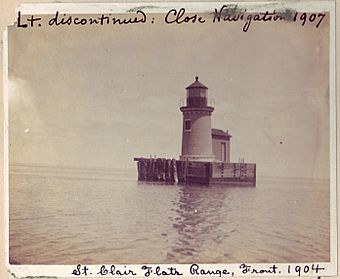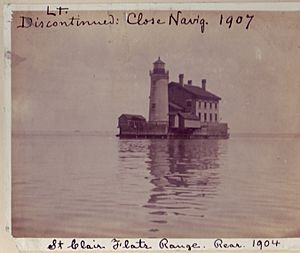St. Clair Flats Front and Rear Range Light facts for kids
Quick facts for kids |
|
|
St. Clair Flats South Channel Range Lights
|
|

Front light in 1904
|
|
| Nearest city | Algonac, Michigan |
|---|---|
| Area | 1.5 acres (0.61 ha) |
| Built | 1859 |
| Architectural style | Conical lighthouse towers |
| NRHP reference No. | 90000853 |
| Added to NRHP | May 24, 1990 |
The St. Clair Flats Front and Rear Range Lights are two special lighthouse structures. They stand in the water near the southeastern tip of Harsens Island. This island is located in Lake St. Clair. These lights helped ships navigate safely through the water.
Contents
Why Were These Lighthouses Built?
Back in the late 1830s, people realized that ships needed a better way to travel through the delta. This delta was at the mouth of the Saint Clair River. It was a tricky area for boats to pass through.
In 1842, a group called the Corps of Topographical Engineers suggested digging a deeper channel. This would make it easier for ships. However, President James K. Polk disagreed. So, no money was set aside for this project for ten years.
In 1852, some money was finally approved for improvements. But it wasn't enough to make a big difference. Meanwhile, a new canal opened in Sault Ste. Marie. This meant more ships were using the Great Lakes. The Saint Clair delta became a major problem spot for trade.
Challenges and Solutions for Shipping
Many ships got stuck in the area in the early 1850s. This often blocked the whole canal. Other ships couldn't get through. Congress tried to approve more money in 1854. But President Franklin Pierce stopped the bills. He did this again in 1855 and 1856.
The problem was very serious by 1856. So, Congress voted again and approved $45,000. This time, they went against the President's decision. With this money, the canal was dug deeper. Also, two lighthouses and a beacon were built at the channel's entrance. These two lighthouses were finished by 1859.
In 1866, more money was approved for improvements. However, the United States Army Corps of Engineers suggested building a new channel. This new channel opened in 1870. The older channel became less important, but ships still used it.
Changes and Repairs Over Time
In 1875, the front lighthouse started to lean. Workers took it apart and rebuilt it. They used the same stone and wood from before. By the early 1900s, the lights were not used as much. In 1907, they were turned off.
But in 1915, the lights were turned back on. They continued to be used until 1934. Then, they were turned off again.
Even after being rebuilt in 1875, the front light kept leaning. This was because the ground near its base was wearing away. In 1990, workers strengthened the base. They built a steel wall and filled it with rocks. This helped support it for a while. In 1996, a strong seawall was built around the front light's island. This made it permanently safe.
The rear light originally had a large house for the lighthouse keeper. This house was taken down in the early 1930s. Over time, the rear light has been damaged. It also needs major repairs to its base. Work is currently being done to fix the rear light.
What Do the Lighthouses Look Like?
The two lighthouse towers stand in shallow water. They are almost a mile away from the closest land.
The front range light is the smaller one. It is a round tower made of yellow bricks. It stands 17 feet tall. It is wider at the bottom (11 feet across) and narrower at the top (10 feet across). It sits on a stone base. This base is on top of a wooden structure hidden underwater.
A single square door at the bottom leads inside the tower. There is a round iron staircase that goes up to the top. The light originally had a ten-sided iron top and a fancy iron railing. These parts are now gone. The light used for navigation now has a plastic lens.
The larger, rear range light is also a round brick tower. It sits on a square stone base. It is made of off-white bricks, which are a bit lighter than the yellow bricks of the front light. This tower is about 40 feet tall. Its original ten-sided iron top is still there. A round entrance at the bottom and a circular iron staircase lead up to the light platform.




